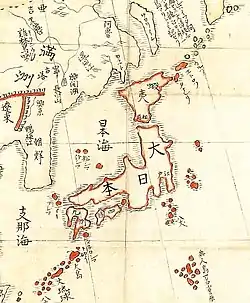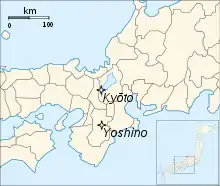Ryakuō
Ryakuō (暦応) was a Japanese era of the Northern Court during the Era of Northern and Southern Courts,[1] lasting from August 1338 to April 1342.[2] The emperor in Kyoto was Emperor Kōmyō (光明天皇, Kōmyō-tennō).[3] Go-Kōgon's Southern Court rival in Yoshino during this time-frame was Emperor Go-Murakami (後村上天皇, Go-Murakami-tennō).
| History of Japan |
|---|
 |
Nanboku-chō overview
During the Meiji period, an Imperial decree dated March 3, 1911 established that the legitimate reigning monarchs of this period were the direct descendants of Emperor Go-Daigo through Emperor Go-Murakami, whose Southern Court (南朝, nanchō) had been established in exile in Yoshino, near Nara.[4]
Until the end of the Edo period, the militarily superior pretender-Emperors supported by the Ashikaga shogunate had been mistakenly incorporated in Imperial chronologies despite the undisputed fact that the Imperial Regalia were not in their possession.[4]
This illegitimate Northern Court (北朝, hokuchō) had been established in Kyoto by Ashikaga Takauji.[4]
Change of era
Southern Court Equivalents
Notes
- Titsingh, Isaac. (1834). Annales des empereurs du japon, pp. 294-296.
- Nussbaum, Louis-Frédéric. (2005). "Ryakuō" in Japan encyclopedia, p. 796; n.b., Louis-Frédéric is pseudonym of Louis-Frédéric Nussbaum, see Deutsche Nationalbibliothek Authority File Archived 2012-05-24 at Archive.today.
- Titsingh, Isaac. (1834). Annales des empereurs du japon, pp. 294-297; Nussbaum, p. 541.
- Thomas, Julia Adeney. (2001). Reconfiguring modernity: concepts of nature in Japanese political ideology, p. 199 n57, citing Mehl, Margaret. (1997). History and the State in Nineteenth-Century Japan. p. 140-147.
- Titsingh, p. 294.
- Pankenier, David. (1999). Archaeoastronomy in East Asia: Historical Observational Records of Comets and Meteor Showers from China, Japan, and Korea, p. 164., p. 164, at Google Books
References
- Nussbaum, Louis Frédéric and Käthe Roth. (2005). Japan Encyclopedia. Cambridge: Harvard University Press. ISBN 978-0-674-01753-5; OCLC 48943301
- Titsingh, Isaac. (1834). Nihon Ōdai Ichiran; ou, Annales des empereurs du Japon. Paris: Royal Asiatic Society, Oriental Translation Fund of Great Britain and Ireland. OCLC 5850691
External links
- National Diet Library, "The Japanese Calendar" – historical overview plus illustrative images from library's collection
| Preceded by Kenmu |
Era or nengō Ryakuō 1338–1342 |
Succeeded by Kōei |

